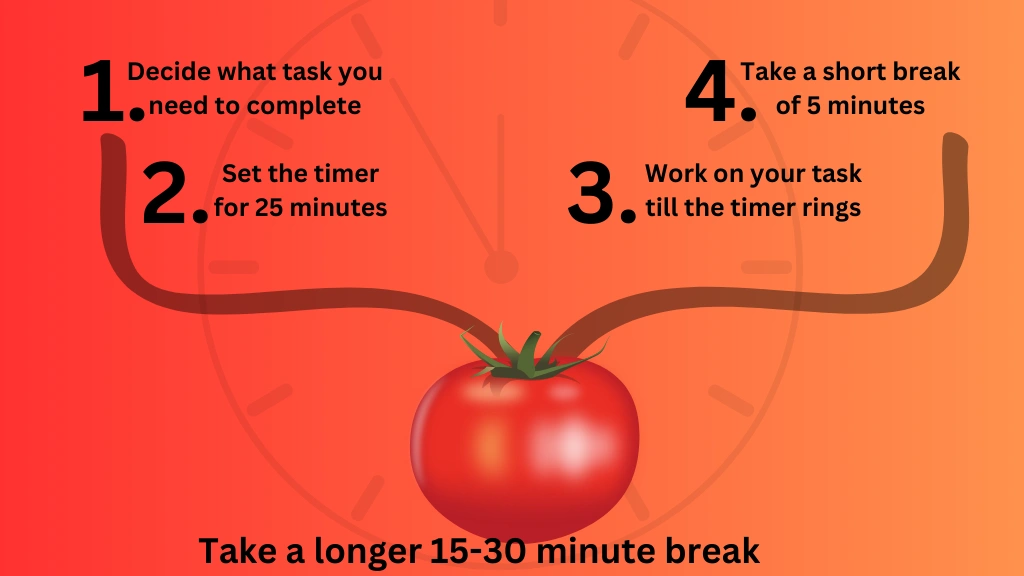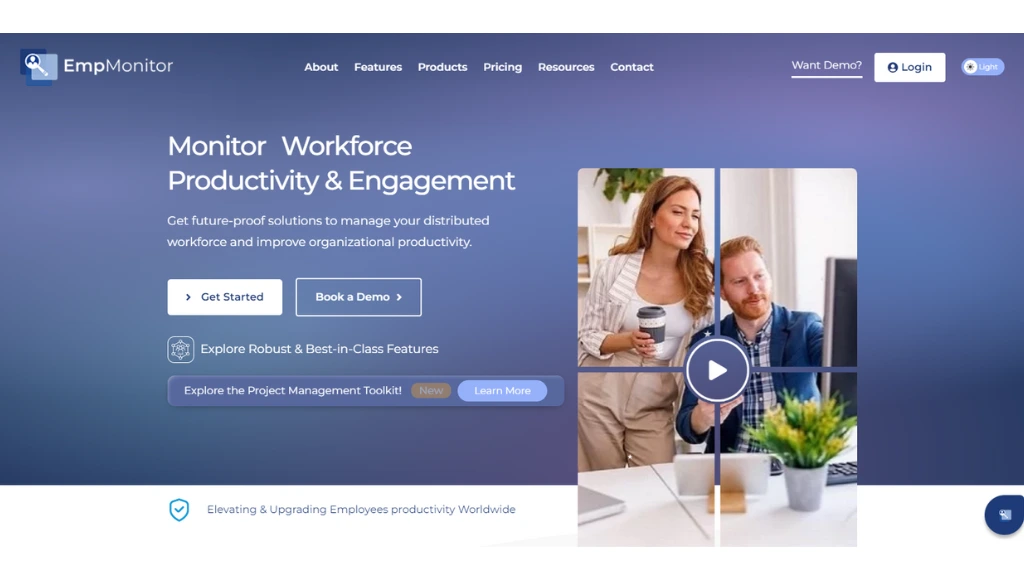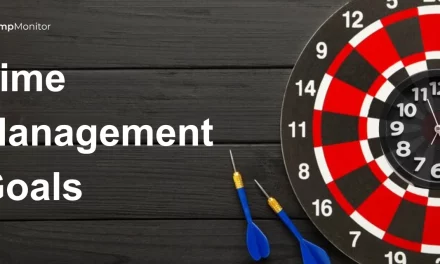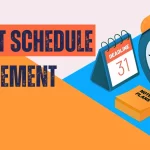The Flowtime technique holds remarkable potential for elevating productivity and concentration.
Seated at your desk, you assess the workload ahead. Your tasks seem to stare back at you, and a glance at the clock reveals 24 minutes remaining in your scheduled 25-minute work interval.
Determined, you engage in your work, only to be abruptly interrupted by the alarm. If only there were a technique similar to the Pomodoro method but with time intervals better suited to your workflow!
The technique that you are looking for is the flowtime technique. It is a set of steps that aid in better time management and support you to enhance your productivity.
These steps, ranging from establishing clear goals to removing distractions, are tailored to create an environment conducive to effective work.
Embrace the straightforwardness of these techniques to unlock your potential for increased efficiency and success in various facets of your life.
In a hurry? Listen to the blog instead!
But What Is The Flowtime Technique?
It is a time management approach suitable for creatives, developers, students, and anyone involved in tasks demanding deep concentration. Its essence lies in selecting a task, working on it until fatigue sets in, then taking a break.
The process is continued repetitively until the task comes to an end. It may seem uncomplicated, but it effectively enhances productivity by promoting a state of flow—a concentrated mental focus—while allowing for necessary rest.
This method ensures complete concentration on the current task, reducing the likelihood of wandering thoughts like, “What should I have for dinner?” or “What are the writers from my favorite childhood novels up to now?”
This piece delves into the Flowtime technique, its benefits, and how adopting it can propel your productivity to new heights.
To get a better understanding of how the technique enhances productivity, let’s explore why it stands out as a viable alternative to the Pomodoro technique and what this Pomodoro method is.
The Pomodoro Method:
The Pomodoro method, created by Francesco Cirillo in the 1990s, derives its name from the pomodoro-shaped kitchen timer (pomodoro means “tomato” in Italian) that Cirillo employed to track his work progress.
Flowtime is a technique that involves focusing on your job for a while and then taking a break. You can repeat this cycle as required until you finish your day’s task.
While the Pomodoro method works well for taxes or cleaning, it falls short for creative or problem-solving tasks. The fixed 25-minute intervals can be too small for deep thinking and disrupt your flow.
On the other hand, Flowtime lets you pick your time frames that match your workflow, fixing these issues.
Maximize Productivity Through The Use Of Flowtime Technique:
Having grasped the idea behind the technique, let us explore ways to optimize its use and increase employee productivity. Together, let’s delve into practical strategies and tips to increase your productivity and improve your workflow, enabling you to achieve a state of deep focus and peak performance.
Focus Only On A Single Task At A Time And Avoid Multitasking:-
The sole firm rule of the Flowtime technique is focusing on one task at a time- a practice also referred to as unitasking. While juggling multiple tasks might appear more efficient, research indicates otherwise.
Studies show that the human brain is not created to handle many tasks simultaneously. When you multitask, you are likely to lose focus and make errors, which results in incomplete tasks and errors.
Providing your full attention to a single task yields superior results.
Eliminate All Sources Of Distractions:-
You should remove all distractions before starting to work, which is obvious. You likely know what distracts you the most, whether it’s social media or chatting with colleagues.
Before diving into work, make sure to:
- Shut down all notifications.
- Set your phone to silent mode, or better- keep it in another room.
- Wear noise-canceling headphones.
- Inform your coworkers that you’re working on something important to avoid interruptions.
- Clear your desk, leaving only the essentials (and maybe a cup of coffee or a snack).
- Keep a piece of paper handy to jot down thoughts that need attention later, like bills to pay or calling a friend. Write them down and stay focused on your task. These thoughts are important but not urgent; you can address them during your next break.
Employ A Time Tracking Software:-
The Flowtime technique is a time management approach where you select a task, work on it until you feel fatigued, and then take a break. This process goes on till the completion of the task.
Utilizing time-tracking software can enhance the technique by automating timesheet entries. It includes capturing the date, check-in/check-out times, hours worked, tasks performed, and a brief description of the task or project.
EmpMonitor, one of the best time management software, aids in steering clear of multitasking by promoting focused work. It assists in task prioritization and allocates specific time slots for each task. This software helps you in setting up a proper time management strategy.
Let us know something about this impressive work time tracking software called EmpMonitor.
EmpMonitor- The Most Efficient Work And Time Management Software
EmpMonitor catches the eye as the premier time tracking software for employees, simplifying productivity with its user-friendly features. It effortlessly aids the Flowtime technique by tracking work hours, monitoring tasks, and providing insightful reports.
With intuitive interfaces and customizable options, EmpMonitor ensures seamless time tracking, allowing you to concentrate intensely on your tasks. Its efficiency streamlines workflow and provides valuable insights for better time allocation. It is also the best remote work time management software for businesses employing remote workers.
It contributes to the effectiveness of the technique by:
- Monitoring task durations:
Time tracking enables the consolidation of time spent on a task into a single duration, providing a clearer understanding of the time needed for specific activities and facilitating accurate scheduling.
- Enhancing workflow:
Utilizing a time-tracking application helps streamline your workflow. Like a Pomodoro timer, it assists in monitoring work and break intervals, contributing to a more organized and structured work routine.
- Improving task estimates:
Flowtime data gathered through time tracking allows for a comprehensive analysis of the time allocated to various tasks. This information proves valuable in creating more accurate estimates for the duration of future projects.
EmpMonitor, a comprehensive workforce management software, also provides a range of other functions like:
-
Employee monitoring
-
Attendance management
-
User tracking
-
Project and task management
-
Real-time insights
-
Time tracking
-
User activity monitoring
-
Insider threat prevention
-
Attendance monitoring
-
Workforce productivity and engagement.
Managers and employees can also use the software to track the time spent on specific tasks and improve their productivity out of their work.
Now that we have learned about this powerful software- let us return to our blog.
Avoid Disrupting Your State Of Flow With Obligatory Breaks:-
It’s crucial to recognize that while determining ideal time intervals is significant, they are not inflexible. Even when the timer signals a break, it’s not obligatory if you’re in a productive flow.
The key is attentiveness to your mental and physical state—nothing is mandatory except unitasking, and you adapt everything according to your current work habits. This adaptability ensures a personalized approach that aligns with your unique needs and preferences.
When you include these points in your flowtime technique, it boosts your productivity and helps in increasing your efficiency. This technique also has its merits and demerits.
Let us know about them in brief.
Also Read:
Make Your Employees More Productive With Six Simple Tips!
Why Should Effective Time Management Be Used Routinely?
08 Tips To Improve Productivity In The Workplace
Merits And Demerits Of Flowtime Technique:-
Like everything else, time management techniques aren’t flawless, and this technique is no exception.
Here are the key pros and cons of Flowtime simplified.
Merits:
Here’s why using the Flowtime technique can be helpful:
Personalized Approach:
Customizing time intervals aligns with your unique workflow. It’s like having a tailored suit – while a mass-produced one can work, it can’t match the fit of a personalized suit. Experiment until you find the break schedule that works for you if the standard 25-minute work and 5-minute break pattern doesn’t suit you.
Improved Focus:
Flowtime facilitates deep work by allowing breaks when needed. Complete immersion in tasks becomes simpler when your mind is refreshed and rested.
Better Time Estimation:
Tracking varied time intervals enhances your time awareness. It leads to benefits such as a clearer understanding of time usage, more accurate time estimates, increased productivity, and reduced procrastination.
Demerits:
If you’re using the Flowtime technique, keep these points in mind:
Time Experimentation:
Finding the ideal time intervals takes time and experimentation. The technique doesn’t instantly show its full potential; it requires some trial and error to discover what suits you best. Be patient throughout this process.
Effective Planning:
Successful implementation of this technique involves planning. You need to know your tasks beforehand, estimate their time requirements, and prioritize them accordingly.
Unsuitable for Unpredictable Schedules:
If your work involves frequent unexpected meetings and sudden urgent tasks, the Flowtime technique might not be the best fit. Maintaining a structured routine with planned breaks can be difficult in a dynamic and unpredictable environment.
Conclusion:
In conclusion, mastering the Flowtime technique opens the door to enhanced productivity and concentrated work. Tailoring time intervals, eliminating distractions, and incorporating tools like EmpMonitor integrate this method into your workflow effortlessly.
The technique’s adaptability allows for a personalized approach, amplifying efficiency and time awareness. While its merits include heightened focus and improved time estimation, acknowledging the need for experimentation and effective planning is crucial.
The Flowtime scenario illustrates how this technique fosters a focused and satisfying work experience, making it an ideal choice for those seeking personalized time management.
Embrace EmpMonitor for a hassle-free, successful approach to effective time management, facilitating a more focused and productive Flowtime experience.


















